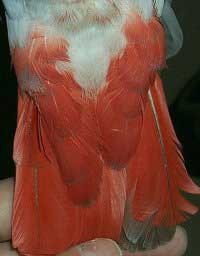Visual Sexing of African Grey

6 Differences Between Male & Female African Grey Parrots
Male African Grey Parrot:1- Male African Grey Parrots are usually larger. They are almost 12-14 inches in height. 2- Male African Grey Parrots have smaller neck than female. Their head is small and flattered. 3- The body of male African grey parrot is somewhat rounded. 4- The tail feathers of the male African Grey Parrot will be fully red in color. 5- The underside of feathers the Male African Grey Parrots will be dark Gray. 6- Male African Grey parrots have eye patches that have pointed ends. |
Female African Grey Parrot:1- Female African Grey Parrots are usually smaller and their height is less than 12-14 2- Female African Grey Parrots have longer neck. They have larger and rounded head. 3- The body of female African Grey Parrot is elliptical and slender. 4- The female African Grey parrot’s tail feathers are also red, but they will possess silver hues. 5- The underside of feathers the Female African Grey Parrots will be light Gray. 6- Female African Grey parrots have eye patches that are rounded. |

Visual Sexing African Grey through Feather Collection (DNA)
For knowledge about Visual Sexing African Grey through Feather Collection (DNA) you can read my this article : Feather Collection for DNA
Visual Sexing African Grey through Blood Collection (DNA)
For knowledge about Visual Sexing African Grey through Blood collection (DNA) you can read my this article : Blood Collection for DNA
Visual Sexing African Greys throught Tail
Most African parrots can be easily sexed after they have molted once. While it is not advisable to determine the sex visually for breeder pairs, identifying the sex of a pet for an owner (without DNA sexing or surgical sexing) will make owners happy. African grey parrots (Psittacus erithacus erithacus) are usually easy to sex. Males have a solid red tail on the underside (the secondary retrices), while those of the hen are tipped in silver. While examining proven pairs, this has proven to be accurate in over 95% of the pairs. Also, with male greys, the underside of the wings is very dark, while those of the hen are lighter grey. This only holds true for the nominate species, and not for the Timneh grey
| MALES | FEMALES |
 |
 |
 |
 |
 |
 |
 |
 |
